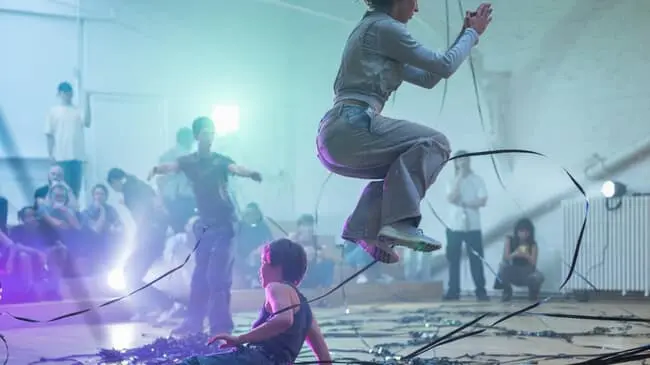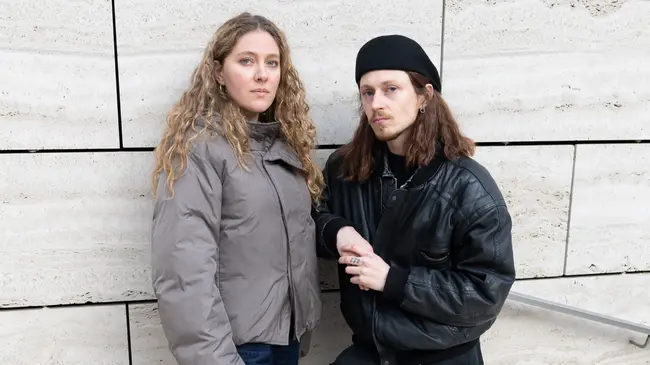Dreams of labour

In a market on the outskirts of Lima (Peru), a group of women sit at a kiosk and paint on shoe soles for hours on end. For more than nine months, visual artist Jimena Chávez Delion conducted intensive research on the informal economy behind these counterfeit shoes. She got to know these women and, more specifically, their dreams. Currently displaying her work as a part of the Art Contest 23 exhibition at Botanique, she tells us about her process and approach towards research and creation. Jimena was awarded the Prix Sabam for Culture on the day of the ceremony.
How would you say your work has evolved since the last time we spoke?
My work is focused on different interactions in urban spaces, mainly in areas constructed around informal economies. I'm originally from Peru, where more than 73% work informally, so much of my work is influenced by this context. I am interested in exploring the interplay between materiality, affectivity, and precariousness in the spaces where I work. This has evolved in my practice through shifting from materiality and collecting processes to a testimonial realm, immersing myself in personal storytelling.
<img class="editorial-image-50-left" src="https://cdn.prod.website-files.com/61eebcc683107b99137f4423/659fdd4ecc44afbb6bb84684_Jimena%20Chavez%20Delion%20(c)%20Linde%20StevensJimena%20Chavez%20Delion%20(c)%20Linde%20Stevens7.webp"/>
<img class="editorial-image-50-right" src="https://cdn.prod.website-files.com/61eebcc683107b99137f4423/659fdd4fe6dda1f5e907b866_Jimena%20Chavez%20Delion%20(c)%20Linde%20StevensJimena%20Chavez%20Delion%20(c)%20Linde%20Stevens5.webp"/>
The last time we met, I presented a video installation at S.M.A.K., exploring different dimensions of transactions in commercial areas in Brussels and Antwerp. There, I delved into how these spaces harbour interpersonal and intercultural relationships beyond their economic aspects.
After that, I spent some time in Lima working on Awakening the Pulse, the work now exhibited at Artcontest 2023. I started going a lot to a footwear supply market in Lima to do research. There is a lot of counterfeiting there. Some people only work on the upper side of the shoe, some just work on the soles, and some sell the materials. Quite hidden, I saw these women painting the sneaker soles by hand. When I saw them working so meticulously, I began to wonder a lot about this specific labour and the women carrying out this specific artisanal work. This became my focus for this project.
<img class="editorial-image-50-left" src="https://cdn.prod.website-files.com/61eebcc683107b99137f4423/659fdf00520231aeda231bed_Jimena%20Chavez%20Delion%20(c)%20Linde%20StevensJimena%20Chavez%20Delion%20(c)%20Linde%20Stevens19.webp"/>
<img class="editorial-image-50-right" src="https://cdn.prod.website-files.com/61eebcc683107b99137f4423/659fdd50edf7b715a606be78_Jimena%20Chavez%20Delion%20(c)%20Linde%20StevensJimena%20Chavez%20Delion%20(c)%20Linde%20Stevens30.webp"/>
When I saw them working so meticulously, I began to wonder a lot about this specific labour and the women carrying out this specific artisanal work
This project is very research-based. What was our approach toward interviewing these women?
The starting point was about their practice itself. It was sincere to have that approach. It’s a thing we have in common: I’m an artist, I also work with different materials.
I was analysing their repetitive, painstaking work. In a way, I recognised myself in some of the practices. I also used to do a lot of repetition for some of my works and had experienced dreams about the work I was doing. I asked them if they had the same experience, and the immediate answer was yes. This became the main focus of the documentary.
I initially planned to stay two months, and I ended up with nine months of recording. It was important for me to respect the people I was interviewing. It’s very easy for someone who’s not from a particular context to just extract.
I initially planned to stay two months, and I ended up with nine months of recording
<img class="editorial-image-50-left" src="https://cdn.prod.website-files.com/61eebcc683107b99137f4423/659fdd4fcc9d0312d92e2688_Jimena%20Chavez%20Delion%20(c)%20Linde%20StevensJimena%20Chavez%20Delion%20(c)%20Linde%20Stevens28.webp"/>
<img class="editorial-image-50-right" src="https://cdn.prod.website-files.com/61eebcc683107b99137f4423/659fdd4f1fde9eb204c2d9a4_Jimena%20Chavez%20Delion%20(c)%20Linde%20StevensJimena%20Chavez%20Delion%20(c)%20Linde%20Stevens27.webp"/>
In the documentary, there seems to be a contrast between this repetitive labour and more aspirational dreams. Can you tell me more about that and how this structures the documentary?
Most of the female workers are migrants from Venezuela as well as from within Peru (outside the capital). After some time of interviews, they started sharing about their personal lives and their aspirations. There was this reoccurring dream of going back home. They didn’t want to abandon their home. Venezuela has a difficult political and economic context that led a lot of people to leave.
<img class="editorial-image-50-left" src="https://cdn.prod.website-files.com/61eebcc683107b99137f4423/659fdd4e43099ebeffe1c0a8_Jimena%20Chavez%20Delion%20(c)%20Linde%20StevensJimena%20Chavez%20Delion%20(c)%20Linde%20Stevens24.webp"/>
<img class="editorial-image-50-right" src="https://cdn.prod.website-files.com/61eebcc683107b99137f4423/659fdd4e52b7e5471b8ee83f_Jimena%20Chavez%20Delion%20(c)%20Linde%20StevensJimena%20Chavez%20Delion%20(c)%20Linde%20Stevens31.webp"/>
I decided to build on the language and narrative of a dream. In a dream, you can go from one place to another, there’s no perception of time. I wanted to create a narrative that mirrors the nature of dreams.
While filming, I started to be very aware of the mental load women have. I recognize myself in that. Society expects us to solve everything in different fields of our lives and I wanted to translate that feeling. A lot of them have children and don’t have free time. I wanted to communicate the mental tiredness in the voices and layers of recitation.
Society expects us to solve everything in different fields of our lives and I wanted to translate that feeling
<img class="editorial-image-50-left" src="https://cdn.prod.website-files.com/61eebcc683107b99137f4423/659fdd4d636723eb013de56f_Jimena%20Chavez%20Delion%20(c)%20Linde%20StevensJimena%20Chavez%20Delion%20(c)%20Linde%20Stevens33.webp"/>
<img class="editorial-image-50-right" src="https://cdn.prod.website-files.com/61eebcc683107b99137f4423/659fdd4e79493b3ec1264a39_Jimena%20Chavez%20Delion%20(c)%20Linde%20StevensJimena%20Chavez%20Delion%20(c)%20Linde%20Stevens36.webp"/>
How do the accompanying pieces build on this narrative?
In the same line of this tiredness, I also wanted to work on some pieces that belong to the environment of the market and counterfeiting. I wanted to use the image of a tower of unfinished orders, a strong foam object that mirrors the tension and workload. For the arch sculpture, I contemplated dreams and how I could play with the concept of a step that acts as a character or entity, wandering around the walls and ceilings.
I also made an order note out of moulded glass. In the kiosk, workers would receive notes specifying the type of shoes to make, the brands, and the quantity. Once completed, they would discard them (I would preserve some of them). These notes exist almost like phantoms, in a liminal space. Glass evokes fragility, reminding me of the precariousness of informal work. The material's main properties resonate with the state of the order note.
The textile piece is part of a series where I started using various laces and accessories, such as hair accessories. Many workers tie their hair while working to maintain an active state. I started to think about tension from the way we attach our hair, and how we feel tension in our head.
<div class="editorial-banner"> <div class=“editorial-credits”> @jimenacdelion / @artcontestasbl / @botanique_expo </div></div>
Different Class works with the interest of their community at heart.
Our work’s purpose is to foster a solid network for independent artists, those who love them, and those who want to support them. Become a member to contribute to the local Belgian art scene.






